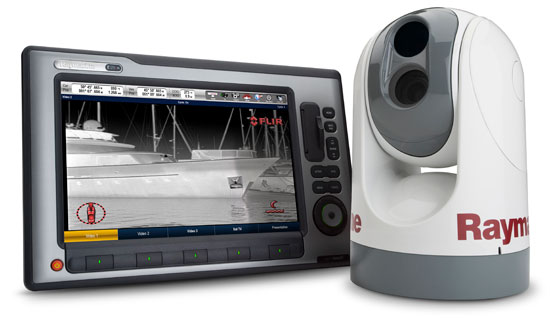A FLIR-Ray of News
Raymarine has just been acquired by FLIR, and you will soon see changes in your marine electronics.
Marine electronics giant Raymarine was acquired by FLIR a couple of months ago, and while we could all guess that this would put Raymarine back in the game for the long term, few of us could have imagined the sparks that would fly as a result. (Read more about the acquisition here).
Sure, FLIR has the capitol to allow Raymarine to invest in improving their old systems, and bring new ones to market. And yes of course, Raymarine will soon be introducing its “own” line of thermal-imaging cameras. But the real story here comes into play when you consider networking capabilities.
Why would FLIR have strong networking systems? This company has its roots in the military establishment, and has created security systems that include a plethora of imaging cameras, panoramic monitors, proximity alarms, and even radar—and tied them all together. It’s a short jump to take their technology, called the Nexus System, into the marine world. Raymarine’s marine world.
This has two major impacts on the Raymarine gear you’re likely to use in the future. First, in the short term, you can expect plug-and-play networked ease of use with RayMarine’s new thermal imagers, the T300 (a single thermal imaging sensor) and the T400 (a dual-imager with a thermal imaging camera and a high-performance low-light video camera). Both of these units, which are similar to FLIR’s existing M series cameras (which cost close to $15,000), feature 360 degree continuous pan, plus or minus 90 degree tilt, ball-up or ball-down mounting options, and E-zoom features. In other words, you can point the housing just about anywhere you darn please, and look at the picture on your E-series or G-series Raymarine displays. The cameras will be controllable via E-series HybridTouch multifunction displays, or on G-series keyboards. Just picture zooming in on an image displayed on your HybridTouch, by placing your fingers on-screen and doing a pinch-and-pull. Sweet.
You’re old fashioned, and you’d rather stick with the traditional joystick camera control? No problem; both units have an optional joystick control available.
Just in case you haven’t used FLIR thermal imaging yet: you’ll be amazed at the picture clarity and detail that can be seen in the black-as-ink distance. In fact, while testing a FLIR on a dark night in Biscayne Bay, I found it possible to pick out everything from boats to pilings to birds sitting on the water. And we’re not talking about those chalky green images that older night vision cameras provide. FLIR uses heat signatures to paint its picture, instead of gathering what little light may or may not be available and magnifying it, as old-tech night vision equipment did.
Want to see the difference for yourself? Check out this before-after video on the FLIR website. The video posted there shows views with and without thermal imaging. Having used the gear myself, I can attest to the fact that what you’ll see on your computer is in fact very similar to what you see in reality, when using these systems.
What about the long term prospects for Nexus and Raymarine? They’re bright—just as bright as those images created on-screen by a FLIR. The companies plan to fully integrate Nexus with Raymarine’s Sea Talk system, bringing FLIR’s high-tech networking experience to bear. You’ll see the end result not just in how the units talk to each other, but also in how you can interact with them. A new Thermal Camera MFD application will soon be available for E-Series Widescreen and G-Series units, with a home-screen icon just like those you see on-screen for the radar, fishfinder, and the other major systems. Seeing in the dark will be as easy as splitting the screen, and you’ll be able to navigate with thermal imaging displayed right next to your standard chartplotter, radar, and fishfinder windows. Owners of older Raymarine gear won’t be left in the dark, either. They’ve introduced a new converter, which will allow legacy products to communicate with the newer units via the SeaTalk network. Surprise bonus: you can get them for the paltry sum of $100.
Although Raymarine does plan to have units shipping before the end of the year, pricing for the T300 and T400 isn’t available yet. Check out the Raymarine and FLIR websites to learn more. Lenny Rudow has been a writer and editor in the marine field for over two decades and has authored five books. He runs his own web site at HookedOnFishingBoats.com and his syndicated blog appears at Boats.com in the BoaterMouth blog section.
Lenny Rudow has been a writer and editor in the marine field for over two decades and has authored five books. He runs his own web site at HookedOnFishingBoats.com and his syndicated blog appears at Boats.com in the BoaterMouth blog section.












